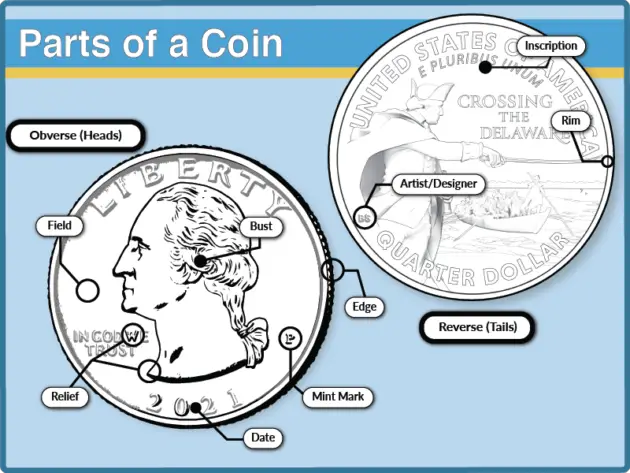Coin Glossary And Diagrams
Those of us who don’t necessarily collect coins but happen to have found some interesting coins in our pocket change (or have inherited a hand-me-down coin collection), we need some of the most basic parts of a coin spelled out for us. Right?
Like… what’s the difference between the edge of a coin and the rim of a coin? (You can find that answer in great detail here.)
What follows are some coin diagrams and photos that will help you describe your coin to others — like if you want to sell it online.
Plus, you will find coin glossaries and definitions that will be helpful as you learn more about your coins.
Okay, let’s dive in and get to know the various parts of a coin…
#1 – Definitions Of The Most Important Parts Of A Coin
This first photo helps you learn about each of the key parts of a coin, including:
- Device – any raised element on the surface of a coin
- Rim – the raised border around each side of a coin
- Edge – the outer surface of a coin that runs around the entire circumference
- Dentils (or Denticles) – the tooth-like raised design around the rim of some earlier U.S. coins
- Obverse – the “heads” side of a coin
- Reverse – the “tails” side of a coin
- Legend (or Inscription) – the main words or lettering on a coin
- Motto – secondary lettering that conveys a short phrase (such as “In God We Trust”)
- Denomination – the face value of a coin
- Mintmark – a small letter struck onto the coin to indicate where the coin was made
- Date – the year that identifies when the coin was struck
- Exergue – the space on a coin below or around the design, often used for the date
- Field – the smooth, flat “blank” area that appears behind a coin’s raised design (“relief”)
- Relief (not shown in this image) – the markings on a coin that are raised above the coin’s smooth, flat surface (“field”)

#2 – Diagram Of The Basic Parts Of A Coin
This next photo from the U.S. Mint highlights the most basic parts of a coin, including:
- The obverse vs. reverse sides of a coin
- The difference between the edge and rim of a coin
- The location of the inscription and mint mark on a coin
- Where the bust, date, and artist/designer’s initials might appear on a coin
- An example of “relief” vs. “field” on a coin

The U.S. Mint website for kids has a wealth of resources available for beginners!
#3 – Coin Glossaries
And finally, coin terms and abbreviations can be confusing.
Check out these coin glossaries which describe the most popular words used to identify and describe U.S. coins. Each is a little different in its own way:
- Coin Collecting Words, Abbreviations, Acronyms & Meanings
- Numismatic Glossary Of Coin Terms
- Coin Lingo: The Language Of Coin Collectors
I like to help people find unique ways to do things in order to save time & money — so I write about “outside the box” ideas that most wouldn’t think of. As a lifelong dog owner, I often share my best tips for living with and training dogs. I worked in Higher Ed over 10 years before switching gears to pursue activities that I’m truly passionate about. I’ve worked at a vet, in a photo lab, and at a zoo — to name a few. I enjoy the outdoors via bicycle, motorcycle, Jeep, or RV. You can always find me at the corner of Good News & Fun Times as publisher of The Fun Times Guide (32 fun & helpful websites).

